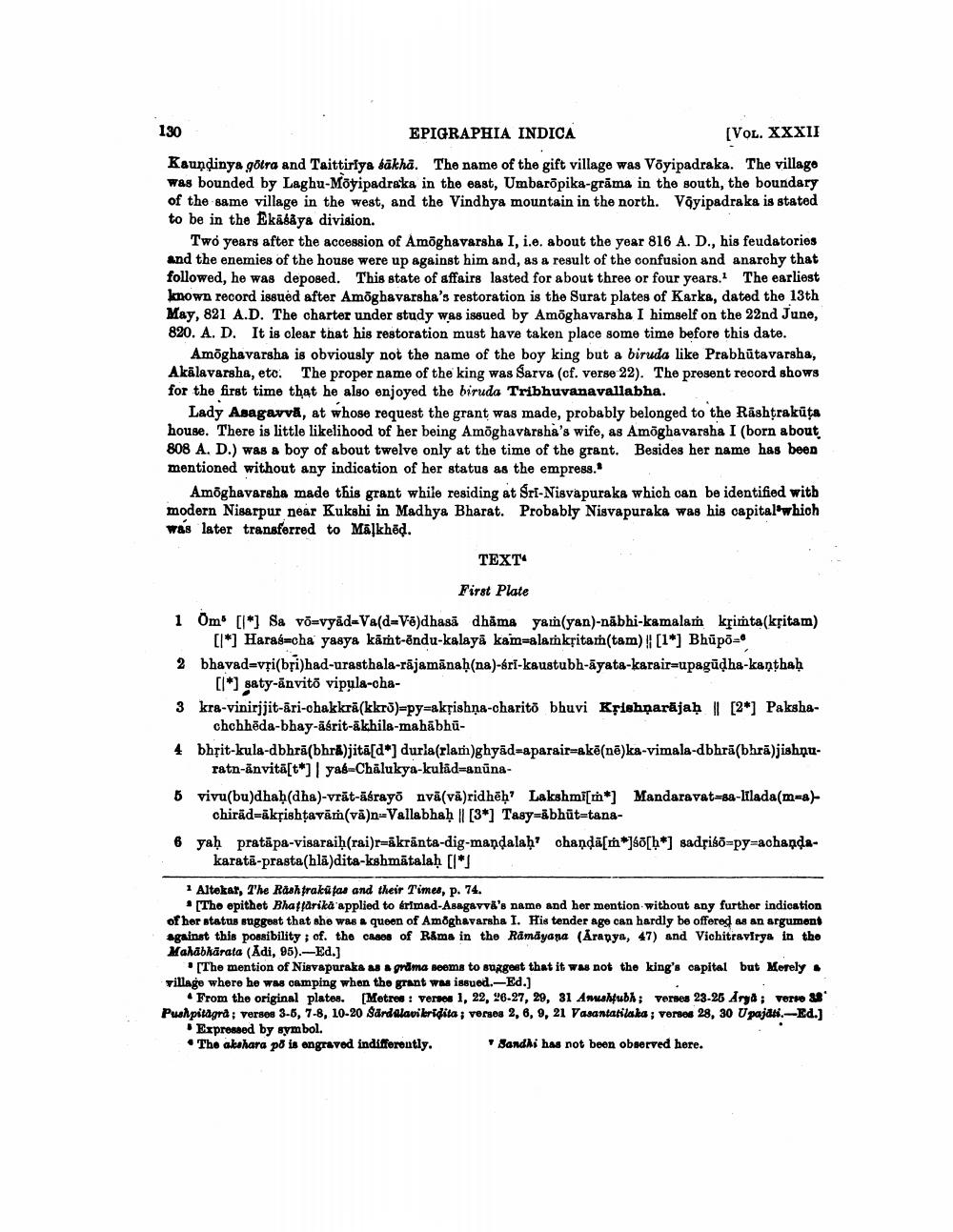________________
130
EPIGRAPHIA INDICA
[VOL. XXXII Kaundinya götra and Taittiriya sakha. The name of the gift village was Vōyipadraka. The village was bounded by Laghu-Moyipadraka in the east, Umbarōpika-grāma in the south, the boundary of the same village in the west, and the Vindhya mountain in the north. Vōyipadraka is stated to be in the Ekasaya division.
Two years after the accession of Amoghavarsha I, i.e. about the year 816 A. D., his feudatories and the enemies of the house were up against him and, as a result of the confusion and anarchy that followed, he was deposed. This state of affairs lasted for about three or four years. The earliest known record issued after Amoghavarsha's restoration is the Surat plates of Karka, dated the 13th May, 821 A.D. The charter under study was issued by Amoghavarsha I himself on the 22nd June, 820. A. D. It is clear that his restoration must have taken place some time before this date.
Amoghavarsha is obviously not the name of the boy king but a biruda like Prabhutavarsha, Akalavarsha, etc. The proper name of the king was Sarva (cf. verse 22). The present record shows for the first time that he also enjoyed the biruda Tribhuvanavallabha.
Lady Asagavva, at whose request the grant was made, probably belonged to the Rashtrakuta house. There is little likelihood of her being Amoghavarsha's wife, as Amoghavarsha I (born about 808 A. D.) was a boy of about twelve only at the time of the grant. Besides her name has been mentioned without any indication of her status as the empress."
Amōghavarsha made this grant while residing at Sri-Nisvapuraka which can be identified with modern Nisarpur near Kukshi in Madhya Bharat. Probably Nisvapuraka was his capital which was later transferred to Malkhöḍ.
TEXT
First Plate
1 Om [*] Sa võ-vyad-Va(d-Vē)dhasa dhama yam(yan)-nābhi-kamalam krimta(kritam) [*] Haras-cha yasya kamt-endu-kalaya kam-alamkṛitam(tam) [1*] Bhupō="
2 bhavad-vri(bri)had-urasthala-rājamānaḥ(na)-árī-kaustubh-ayata-karair-upagūḍha-kanthaḥ
[*] saty-anvito vipula-cha
3 kra-vinirjjit-Bri-ohakkrå(kkr3)-py-akrishna-charito bhuvi Krishnarajah [2] Pakshachchheda-bhay-äśrit-äkhila-mahābhu
4 bhrit-kula-dbhrā(bhrā)jitā[d*] durla(rlam)ghyād-aparair-akē(në)ka-vimala-dbhrā(bhrā)jishņuratn-anvitā[t*]| yaé-Chalukya-kulad=anūna
5 vivu(bu)dhaḥ(dha)-vrat-äśrayō nvā(va) ridhēḥ' Lakshmi[m*] Mandaravat-sa-lilada(m=a)chirad-krishṭavāṁ(vā)n-Vallabhaḥ | [3*] Tasy-&bhat-tana
6 yah pratapa-visaraiḥ(rai)=ākrānta-dig-mandalah chanda[m*[*] sadrid-py-achandakarata-prasta (hla)dita-kshmatalaḥ [*]
1 Altekar, The Rashtrakutas and their Times, p. 74.
[The epithet Bhattarika applied to erimad-Asagavvä's name and her mention without any further indication of her status suggest that she was a queen of Amoghavarsha I. His tender age can hardly be offered as an argument against this possibility; of. the cases of Rams in the Rāmāyaṇa (Aranya, 47) and Vichitravirya in the Mahabharata (Adi, 95).-Ed.]
[The mention of Nisvapuraka as a grāma seems to suggest that it was not the king's capital but Merely village where he was camping when the grant was issued.-Ed.]
From the original plates. [Metres: verses 1, 22, 26-27, 29, 31 Anushtubh; verses 23-25 Arga; verse 38' Pushpitägra; verses 3-5, 7-8, 10-20 Särdalavikridita; verses 2, 6, 9, 21 Vasantatilaka; verses 28, 30 Upajati.-Ed.] Expressed by symbol.
The akshara po is engraved indifferently.
Sandhi has not been observed here.




